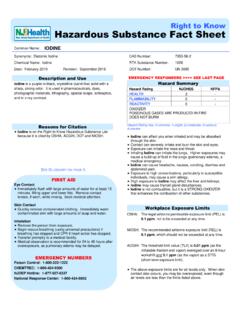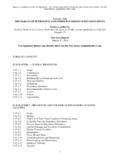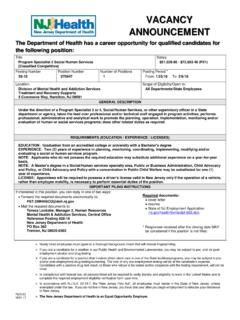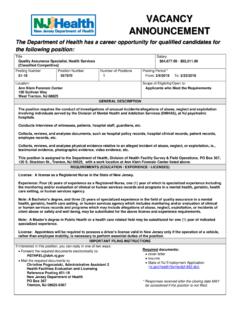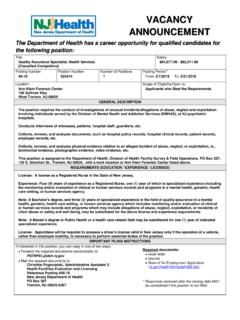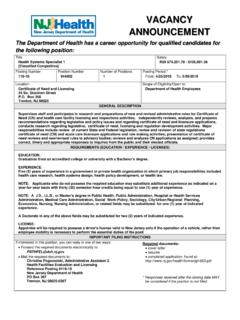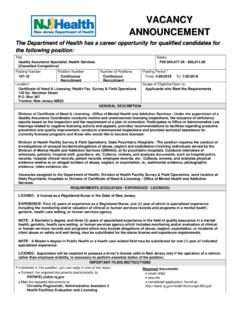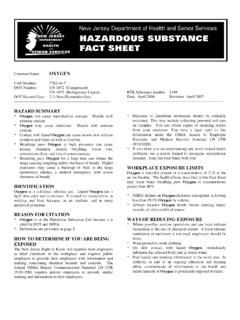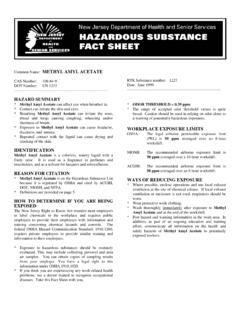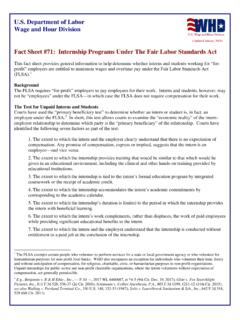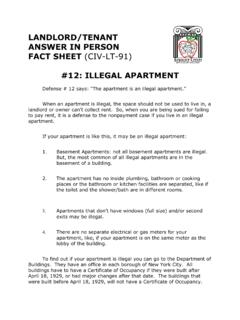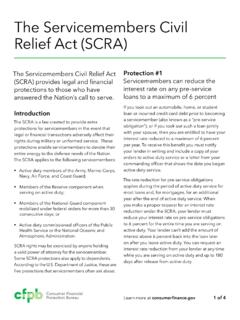Transcription of COPPER CHLORIDE HAZARD SUMMARY Copper Chloride
1 Common Name: COPPER CHLORIDE . CAS Number: 7447-39-4. DOT Number: UN 2802 RTK Substance number: 0532. DOT HAZARD Class: 8 (Corrosive) Date: February 1999 Revision: February 2007. ---------------------------------------- --------------------------------- ---------------------------------------- --------------------------------- HAZARD SUMMARY . * COPPER CHLORIDE can affect you when breathed in. * Exposure to hazardous substances should be routinely * Contact can severely irritate and burn the skin and eyes evaluated. this may include collecting personal and area with possible eye damage. air samples. You can obtain copies of sampling results * Repeated exposure can cause thickening of the skin.
2 From your employer. You have a legal right to this * Breathing COPPER CHLORIDE can irritate the nose, throat information under the OSHA Access to Employee and lungs causing coughing and wheezing. Exposure and Medical Records Standard (29 CFR. * COPPER CHLORIDE can irritate the stomach causing ). salivation, nausea, vomiting, stomach pain and diarrhea. * If you think you are experiencing any work-related health * Repeated exposure can cause shrinking of the inner lining problems, see a doctor trained to recognize occupational of the nose and may cause ulcers and a hole in the bone diseases. Take this fact sheet with you. dividing the inner nose.
3 * COPPER CHLORIDE may damage the liver and kidneys. WORKPLACE EXPOSURE LIMITS. * COPPER CHLORIDE is a DOT CORROSIVE CHEMICAL. OSHA: The legal airborne permissible exposure limit (PEL) is 1 mg/m3 for COPPER dusts and mists and IDENTIFICATION mg/m3 for COPPER fumes, averaged over an COPPER CHLORIDE is a brownish-yellow powder. It is used in 8-hour workshift. petroleum, textiles, metallurgy, photography, agricultural products, and as a feed additive and wood preservative. It is NIOSH: The recommended airborne exposure limit is also used in light sensitive paper manufacturing, pigments for 1 mg/m3 for COPPER dusts and mists and glass and ceramics, and Acrylonitrile manufacturing.
4 Mg/m3 for COPPER fumes, averaged over a 10-hour workshift. REASON FOR CITATION. * COPPER CHLORIDE is on the Hazardous Substance List ACGIH: The recommended airborne exposure limit is because it is cited by DOT, DEP and EPA. 1 mg/m3 for COPPER dusts and mists and * this chemical is on the Special Health HAZARD Substance mg/m3 for COPPER fumes, averaged over an List because it is CORROSIVE. 8-hour workshift. * Definitions are provided on page 5. WAYS OF REDUCING EXPOSURE. HOW TO DETERMINE IF YOU ARE BEING * Where possible, enclose operations and use local exhaust ventilation at the site of chemical release. If local exhaust EXPOSED.
5 Ventilation or enclosure is not used, respirators should be The New Jersey Right to Know Act requires most employers worn. to label chemicals in the workplace and requires public * Wear protective work clothing. employers to provide their employees with information and * Wash thoroughly immediately after exposure to COPPER training concerning chemical hazards and controls. The federal OSHA HAZARD Communication Standard (29 CFR CHLORIDE and at the end of the workshift. ) requires private employers to provide similar * Post HAZARD and warning information in the work area. In training and information to their employees. addition, as part of an ongoing education and training effort, communicate all information on the health and safety hazards of COPPER CHLORIDE to potentially exposed workers.
6 COPPER CHLORIDE page 2 of 6. this fact sheet is a SUMMARY source of information of all Any evaluation should include a careful history of past and potential and most severe health hazards that may result from present symptoms with an exam. Medical tests that look for exposure. Duration of exposure, concentration of the substance damage already done are not a substitute for controlling and other factors will affect your susceptibility to any of the exposure. potential effects described below. ---------------------------------------- ---------------------------------- Request copies of your medical testing. You have a legal right to this information under the OSHA Access to Employee HEALTH HAZARD INFORMATION Exposure and Medical Records Standard (29 CFR ).
7 Acute Health Effects Mixed Exposures The following acute (short-term) health effects may occur * Because more than light alcohol consumption can cause immediately or shortly after exposure to COPPER CHLORIDE : liver damage, drinking alcohol can increase the liver damage caused by COPPER CHLORIDE . * Contact can severely irritate and burn the skin and eyes with possible eye damage. Conditions Made Worse By Exposure * Breathing COPPER CHLORIDE can irritate the nose, throat and * Wilson's Disease is a rare hereditary condition which lungs causing coughing and wheezing. interferes with the body's ability to get rid of COPPER . If * COPPER CHLORIDE can irritate the stomach causing you have this illness, consult your doctor about COPPER salivation, nausea, vomiting, stomach pain and diarrhea.
8 Exposure. Chronic Health Effects WORKPLACE CONTROLS AND PRACTICES. The following chronic (long-term) health effects can occur at some time after exposure to COPPER CHLORIDE and can last for Unless a less toxic chemical can be substituted for a hazardous months or years: substance, ENGINEERING CONTROLS are the most effective way of reducing exposure. The best protection is to Cancer HAZARD enclose operations and/or provide local exhaust ventilation at * According to the information presently available to the New the site of chemical release. Isolating operations can also Jersey Department of Health and Senior Services, COPPER reduce exposure.
9 Using respirators or protective equipment is CHLORIDE has not been tested for its ability to cause cancer less effective than the controls mentioned above, but is in animals. sometimes necessary. Reproductive HAZARD In evaluating the controls present in your workplace, consider: * According to the information presently available to the New (1) how hazardous the substance is, (2) how much of the Jersey Department of Health and Senior Services, COPPER substance is released into the workplace and (3) whether CHLORIDE has not been tested for its ability to affect harmful skin or eye contact could occur. Special controls reproduction.
10 Should be in place for highly toxic chemicals or when significant skin, eye, or breathing exposures are possible. Other Long-Term Effects * Repeated exposure can cause thickening of the skin and In addition, the following control is recommended: may cause a greenish color to the skin and hair. * Repeated exposure can cause shrinking of the inner lining * Where possible, automatically transfer COPPER CHLORIDE of the nose and may cause ulcers and a hole in the bone from drums or other storage containers to process dividing the inner nose. containers. * COPPER CHLORIDE may damage the liver and kidneys. Good WORK PRACTICES can help to reduce hazardous exposures.


